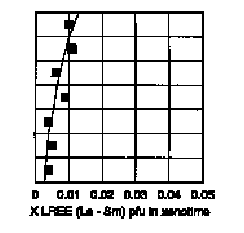T-t paths of high grade metapelites.


We determined Rare Earth Element (plus Y) concentrations of coexisting monazites and xenotimes via EMP in a suite of seven metapelites from the Variscan fold belt in NE Bavaria, Germany. The metapelites include a continuous prograde mainly low pressure (3 to 5 kbar) metamorphic profile starting from greenschist (400°C; sample Tb 163) up to lower granulite facies conditions (700°C; sample Tb 132). LREE (La - Sm) are incorporated preferentially in monoclinic monazites (REO9-polyhedron), HREE plus Y in tetragonal xenotimes (REO8-polyhedron). Both minerals reflect the whole rock REE distribution patterns, monazite for the LREE and xenotime of the HREE limb. The major element concentrations of both REE-phosphates of all rocks are very similiar and do not depend on metamorphic grade. Monazites consist mainly of La, Ce and Nd (La0.20-0.23, Ce0.41-0.45, Nd0.15-0.18)PO4, on average. Concentrations of all other elements are below 6 mol%. Likewise, xenotimes consist mainly of Y (Y0.76-0.80, Dy0.05-0.07, Gd0.04-0.06)PO4 with all other elements being below 5 mol%.
In contrast, the minor HREE concentrations in monazites do increase strongly with increasing metamorphic grade, particularly Y, Dy, and Gd. Y makes up about 70% of all the HREE incorporated in monazites, Gd 20% and Dy 10%. Concentrations increase by a factor of 3 to 5 from greenschist to granulite facies rocks. Moreover, single monazites from medium and high grade rocks often show zonations with cores low in HREE and rims with high HREE contents interpreted as growth zonations during prograde metamorphism. LREE concentrations in xenotimes show a similar behaviour. Sm and Nd increase by a factor of 3 to 4 from low to high temperatures, however, the total amount of LREE in xenotimes is lower than that of HREE in monazites, i.e. the temperature dependency of the solvus is assymmetric (Fig. 1). Prograde zonations in single xenotime crystals were not observed. XHREE in monazites and XLREE in xenotimes of the seven rocks define two limbs along the solvus from broadly 400°C to 700°C (Fig. 1). First results of experimental calibrations at hydrothermal conditions confirm the empirical data.
We believe that the empirical calibration of the monazite solvus limb coexisting with xenotime given in Fig. 1 is appropriate for geothermometry at low pressures. Due to their contents of U and Th, monazites have often been used for U-Pb age determinations. The combination of our empirical thermometer on prograde zoned monazites along with possible age determinations of zoned single crystals may therefore provide information about prograde branches of
T-t paths of high grade metapelites.

Fig. 1.